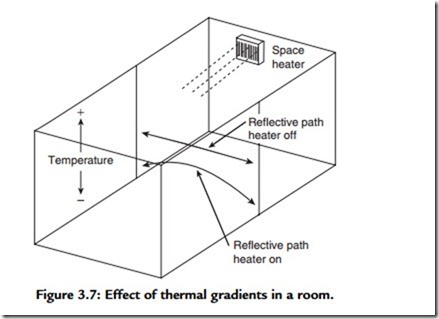Absorption
Absorption is the inverse of reflection. When sound strikes a large surface, part of it is reflected and part of it is absorbed. For a given material, the absorption coefficient (a) is
where EA is the absorbed acoustic energy, EI is the total incident acoustic energy (i.e., the total sound), and (1 – a) is the reflected sound.
This theoretically makes the absorption coefficient some value between 0 and 1. For a = 0, no sound is absorbed; it is all reflected. If a material has an a of 0.25, it will absorb 25% of all sound energy having the same frequency as the absorption coefficient rating, and it will reflect 75% of the sound energy having that frequency.
An anechoic room absorbs 99% of the energy received from the sound source. What percentage of the LP from the source is reflected? Assume 10 W of total energy output from the source. Then the chamber absorbs 9.9 W of it.
Box 3.1 Definitions in Acoustics
Sound Energy Density—is the sound per unit volume measured in joules per cubic meter.
Sound Energy Flux—is the average rate of flow of sound energy through any specified area. The unit is joules per second (joules per second are called watts).
The Sound Intensity (or sound energy flux density)—in a specified direction at a point is the sound energy transmitted per second in the specified direction
through unit area normal to this direction at the point. The unit is watts per square meter.
Sound Pressure—is exerted by sound waves on any surface area. It is measured in Newtons per square meter (now called pascals). The sound pressure is proportional to the square root of the sound density.
(Continued)
Box 3.1 (Continued)
The Sound Pressure Level (in decibels of a sound)—20 times the logarithm to the base 10 of the ratio of the pressure of this sound to the reference pressure. Unless otherwise specified, the reference pressure is understood to be 0.00002 N/m2 (20
micropascals or 20 μPa).
The Velocity Level (in decibels of a sound)—20 times the logarithm to the base 10 of the ratio of the particle velocity of the sound to the reference particle velocity. Unless otherwise specified, the reference particle velocity is understood to be
50 X 10–9 meters per second (m/s).
The Intensity Level (in decibels of a sound)—10 times the logarithm to the base 10 of the ratio of the intensity of this sound to the reference intensity.
Unless otherwise specified, the reference intensity is 10–12 watts per square meter
In other words, 10% of the LP returns as a reflection. If the sound source had directed an LP of a 100-dB signal at the wall of the chamber, a signal of 80 dB would be reflected back. Remembering how dB are combined, we can see that this reflection will not change the 100-dB reading of the direct sound by a discernible amount on any normal sound level meter.
The desirability of a reflective surface can be seen when it is realized that the direct sound and the reflected sound from a single surface can combine to be as much as 3 dB higher than the direct sound alone. If the loudspeakers are directed to reflect off the ground during the cool early morning hours, then when the refraction effect of the sun on the hard surfaces causes the sound to bend upward during the hot part of the day, the sound bends up into the grandstand area. Most of the time, the reflected sound is assisting the direct sound, thereby saving audio power.


